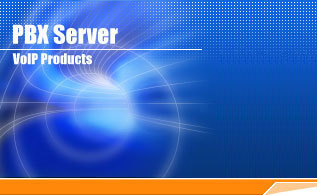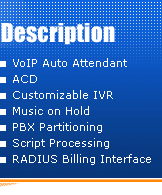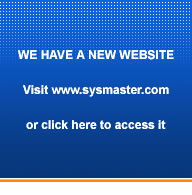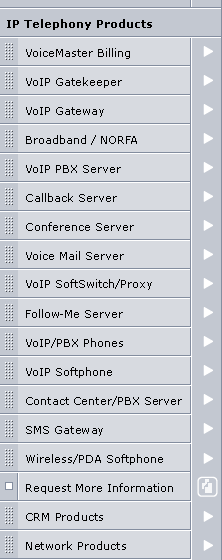|

Key Features
- VoIP - H323/SIP/MGCP Support
- PSTN - ISDN/SS7/CAS/R2 Support
- Inbound Call Filtering
- Least Cost Routing
- Protocol Switching
- Codec Transcoding
- IVR Feature Management
- Dynamic Call Control and Disconnect
- 976/900 Block
- Classes of Service
- Direct Inward Dial (DID)
- Speed 2-digit Dialing
- Anonymous Call Rejection
- Call Forward All Calls
- Call Forward Busy
- Call Forward No Answer
- Managed Call Forward
- Blind Call Forward
- Call Return
- Caller ID
- Caller ID Block
- Caller Name
- Call Waiting
- Caller ID for Call Waiting
- Off-Premises/IP Stations
- Admin Web Management Interface - Enterprise
|
- DTMF Block
- Last Call Redial
- Last Inbound Call Return
- Distinctive Ring
- Do Not Disturb (DND)
- Forward to Voice Mail
- Hold Call
- Park & Park Pickup Call
- N-way Private Conference
- Permanent Per Call Block
- Priority Call
- Last Call Redial
- Group Pickup
- Selective Call Forward
- Selective Call Rejection
- Call Screening
- Call Screening Voice Mail Forward
- Speed Dial
- Urgent Call
- Virtual Ring
- IVR System Management
- Hunt Dial Groups
- Channel Hunt
- Sequential Hunt
- RR Rotational Hunt
- Music On Hold
- Unlimited Auto Attendant Levels
- User Web Management Interface - Enterprise
|
Extended Features
- Automated Call Distribution (ACD)
- Agent Log On/Off
- Automated Agent Logging
- Advanced Queue Management
- Custom IVR Support
- Custom IVR Menu Support
- Custom DTMF Processing
- Custom IVR Prompts
- Unlimited Languages Support
- Radius Billing Interface
|
- Radius Authentication Interface
- CDR Collection
- Advanced Call Reporting
- Advanced ACD Reporting
- Advanced Agent Performance Reporting
- CALEA Compliance
- Call Recording
- Advanced Time Rule Management
- User CRM Interface - Consumer/Hosted Services
- User CRM Management Interface - Consumer/Hosted Services
|
Introduction
The SysMaster VoIP PBX is a standalone, flexible,
and reliable PBX/Class 5 server. It features Automatic Call Distribution
(ACD), Auto Attendant, Voice Mail, Unified Messaging, FAX, Call
Routing, Conference server. It is based on a modular architecture
providing scalability and flexibility in configuring a PBX matching
the needs of your business. It can handle both calls from/to the
PSTN as well as VoIP calls. Due to its VoIP capabilities the SysMaster
VoIP PBX/Class 5 server allows for building a virtual office comprising
multiple remote locations. All PBX management as well as call
initiation can be done via a web interfaces.
Features:
The VoIP PBX/Class 5 sports an intelligent IVR
system which serves the auto attendant. It is available for use
by both the main reception lines and departments. Auto attendant
is also supported at the user/extension level through the voice
mail system. All greeting prompts are completely customizable
by the company and departments.
Auto Attendant Features
Reception
The VoIP PBX/Class 5 is designed to be used with or without
a receptionist answering the inbound phone calls. It can be activated
only for after hours and holidays. It can also be used as a backup
to the receptionist where it is activated only after a specified
number of rings.
Name Dialing
The VoIP PBX/Class 5 auto attendant allows in-bound callers
to route their call to the appropriate person without knowing
their extension. This feature allows for either first or last
name directory look up.
Extension Dialing
In-bound callers may quickly route their call to the
appropriate person if they know the correct extension number.
Group Dialing
The VoIP PBX/Class 5 will allow in-bound callers to route
their call directly to the auto attendant of a group. At the group
or department level, the VoIP PBX/Class 5 auto attendant can be
selectively activated or feature custom messages depending on
the time of day such as non-business hours, departmental meetings,
lunch hours, etc.
Information Messaging
The VoIP PBX/Class 5 auto attendant can be used to play
specific informational messages (without allowing for a voice
mail to be recorded) based on telephone menu prompts.
Custom Call Routing
The CCR feature allows for creating complex menu/submenu
system of options and informational messages.
Automatic Call Distribution
(ACD)
The VoIP PBX/Class 5 ACD provides for automatic call
routing to the next available agent in a group or department.
It includes call queue management when all agents are busy, "sold
on hold," and caller opt-out of queue option. The system
supports up to three levels of queues.
The VoIP PBX/Class 5 supports all the standard
phone voice mail features. But through the graphical user interface,
voice mail becomes particularly useful and easy to manage. When
the user receives a voice mail message, the Administrative console
gives an immediate indicator on the user's PC screen.
Security
The VoIP PBX/Class 5 security is provided through a user
Personal Identification Number (PIN).
Multiple Greetings
The user may define multiple voice mail greetings for
different situations depending on their user status.
Web Based Administrative Console
The console allows users to visually sort and manage
their voice mail messages through the Internet. Each voice mail
message has the CallerID information, date and time of the message,
text notations associated with the message, and the message duration.
Multiple Mailbox Types
Company Directory - informational messages which
lists available directory numbers of users;
Guests Mailbox - mailboxes for people
that do not have permanent directory number;
General Delivery Mailbox - General mailbox
where messages are left and are not for any specific user;
Personal Mailboxes - these are the mailboxes
for each user with a directory number.
Voice Mail Review/Playback/Storing/Deleting
Voice mail messages may be played on the telephone or
the PC speakers. They can be also reviewed, stored and deleted.
Voice Mail Forwarding To Email
Users may choose to have their voice mail forwarded to their email account
as an audio attachment. Voice mail may be forwarded to email on an ad-hoc
or continuous basis, giving the user an easy-to-manage unified messaging
system.
Voice Mail Notification via Email
Users may opt to have a special notification only email
(without the actual audio attachment) sent to them whenever a
new voice mail is received. This will give them an instant alert
via email, cell phone or pager with the CallerID information.
Return Call
Users may place a return call to the sender of the message
with a single mouse click.
Informational Only Mailbox
Mailboxes may be defined to provide informational messages
without recording any voice mail. This can be useful as an end
point for the auto attendant routing to a group mailbox.
Public Conferences
The SysMaster Conference server sets up publicly available conference
rooms where there are no restrictions for joining in. Access control
lists can be imposed.
Private Conferences
Private conferences are password protected conferences where only limited
number of users can join.
Conference Recording
The system allows for full recording of conferences for future review.
All recorded data is stored in digital format.
Real time conference administration
Administrators can create and remove a conference room. They can dynamically
add and remove users from a conference room. All this is done through
a an online web console.
Up to 1024 Concurrent Call Legs
The SysMaster PBX Conference server allows for handling up to 1024 call
legs (i.e. 1024 concurrent users in conference rooms in total). The conference
calls can be from any of the following interfaces H.323, SIP or PSTN.
Call Park
Incoming calls can be put on a specific queue waiting to be further handled.
Call Hold
Calls can be put on on hold at any moment for further handling by the same
or other parties.
Call Transfer
Call scan be transferred to another extension or hunt groups.
Preferences - Speed Dial, DND
The speed dial feature allows administrators to create system level dial
codes that can be used by any telephone terminal connected to the PBX.
The DND (Do Not Disturb) feature allows users to block incoming calls
from ringing their terminal. Automatic forwarding to the user's mailbox
is provided.
Various Hunting Group Scheduling
The PBX/Class 5 server allows for rotary, sequential or broadcast
H323/SIP/PBX/PSTN scheduling of calls.
Rotary - the PBX tries to connect to the terminals
within a hunt group until a free terminal is found. There is no
specified order of picking a terminal.
Sequential - the PBX tries to connect
to terminals in based on a priority list until all terminals are
tried. After that the procedure can be repeated or the call may
be forwarded to a voice mail.
Broadcast - rings each terminal within
a group simultaneously. If a call cannot be connected, it is put
in a waiting queue. When a terminal is free to process the call,
the system redirects call to it.
Comprehensive Call Logs
The system features detailed call logs with possible call recording for
future reference.
Easy Integration
The PBX/Class 5 server can easily integrate with other SysMaster
VoIP products for building comprehensive voice solutions.
|





